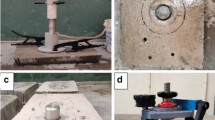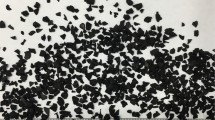Abstract
In this study, rubberized concrete samples were prepared by partial substitution (5 %, 10 % and 20 % replacements by volume) of sand by waste crumb rubber, and tested under impact three-point bending load, as well as static load. Three types of specimens (size 50 × 100 × 500 mm) namely, plain concrete, rubberized concrete, and double layer concrete (with rubberized concrete top and plain concrete bottom) were loaded to failure in a drop-weight impact machine by subjecting to 20 N weight from a height of 300 mm, and another three similar specimens were used for the static load test. In both the tests, the load–displacement and fracture energy of each specimen were investigated. Finite-element simulations were also performed to study the dynamic behaviors of the samples, by using LUSAS V.14 software. It was noticed that, the impact tup, and inertial and bending loads increased with the increase in the percentage of sand replacement by crumb rubber. It was interesting to observe that these effects were more significant in the double layer specimen compared to the plain and rubberized concrete samples. The static peak bending load always decreased with increase of rubber in the mix. In general, the strength and energy absorbing capability of rubberized concrete was better under impact loading than under static loading. The simulated load against displacement behaviors of all the samples were validated by the experimental results.








Similar content being viewed by others
References
Siddique R, Naik TR (2004) Properties of concrete containing scrap-tire rubber -An overview. Waste Manage 24(6):563–569
Wang Y, Wu HC, Li VC (2000) Concrete reinforcement with recycled fibers. J Mater Civ Eng 12(4):314–319
Son KS, Hajirasouliha I, Pilakoutas K (2011) Strength and deformability of waste tyre rubber-filled reinforced concrete columns. Constr Build Mater 25(1):218–226
Khaloo AR, Dehestani M, Rahmatabadi P (2008) Mechanical properties of concrete containing a high volume of tire–rubber particles. Waste Manage 28(12):2472–2482
Reda-Taha MM, El-Dieb AS, AbdEl-Wahab MA, Abdel-Hameed ME (2008) Mechanical, fracture, and microstructural investigations of rubber concrete. J Mater Civ Eng 20(10):640–649
Topcu IB (1995) The properties of rubberized concretes. Cem Concr Res 25(2):304–310
Eldin NN, Senouci AB (1993) Rubber-tire particles as concrete aggregate. J Mater Civ Eng 5(4):478–496
Topcu IB, Avcular N (1997) Collision behaviours of rubberized concrete. Cem Concr Res 27(12):1893–1898
Li G, Stubblefield MA, Garrick G, Eggers J, Abadie C, Huang B (2004) Development of waste tire modified concrete. Cem Concr Res 34(12):2283–2289
Tortum A, Celik C, Aydin AC (2005) Determination of the optimum conditions for tire rubber in asphalt concrete. Build Environ 40(11):1492–1504
Turatsinze A, Bonnet S, Granju JL (2005) Mechanical characterisation of cement based mortar incorporating rubber aggregates from recycled worn tyres. Build Environ 40(2):221–226
Al-Tayeb MM, Abu Bakar BH, Akil HM, Ismail H (2012) Effect of partial replacements of sand and cement by waste rubber on the fracture characteristics of concrete. Polym-Plast Technol Eng 51(6):583–589
Albano C, Camacho N, Reyes J, Feliu JL, Hernandez M (2005) Influence of scrap rubber addition to Portland I concrete composites: Destructive and non-destructive testing. Compos Struct 71(4):439–446
Topcu IB (1997) Assessment of the brittleness index of rubberized concretes. Cem Concr Res 27(2):177–183
Topcu IB, Bilir T (2009) Analysis of rubberized concrete as a three phase composite material. J Compos Mater 43(11):1251–1263
Khatib ZK, Bayomy FM (1999) Rubberized Portland cement concrete. J Mater Civ Eng 11(3):206–213
Guneyisi E, Gesoglu M, Ozturan T (2004) Properties of rubberized concretes containing silica fume. Cem Concr Res 34(12):2309–2331
Ghaly AM, Cahill JD IV (2005) Correlation of strength, rubber content, and water to cement ratio in rubberized concrete. Can J Civ Eng 32(6):1075–1081
American Society for Testing and Materials (ASTM) C192/192 (2006) Standard practice for making and curing concrete test specimens in the laboratory, vol. 4.02, West Conshohocken, PA, USA
American Society for Testing and Materials (ASTM) C39/C39 (2001) Test method for compressive strength of cylindrical concrete specimens. Annual Book of ASTM Standards, Pennsylvania
American Society for Testing and Materials (ASTM) C496 (1996) Test method for splitting tensile strength of cylindrical concrete specimens. Annual Book of ASTM Standards, Pennsylvania
American Society for Testing and Materials (ASTM) C469 (1994) Standard test method for static modulus of elasticity and poisson’s ratio of concrete in compression. Annual Book of ASTM Standards, Pennsylvania
American Society for Testing and Materials (ASTM) C78 (1994) Standard test method for flexural strength of concrete (using simple beam with third-point loading). ASTM International, West Conshohocken
Banthia N. Impact resistance of concrete (1987) PhD thesis, University of British Columbia, Vancouver, B.C., Canada.
Banthia N, Mindess S, Bentur A (1987) Impact behavior of concrete beams. Mater Struct 20(119):293–302
Banthia N, Mindess S, Bentur A, Pigeon M (1989) Impact testing of concrete using a drop weight impact machine. Exp Mech 29(2):63–69
Banthia N, Gupta P, Yan C (1999) Impact resistance of fiber reinforced wet-mix shotcrete. Part 1: beam tests. Mater Struct 32(8):563–570
Oñate E (2009) Structural analysis with the finite element method. Linear Statics, Volume 1: Basis and Solids (Lecture Notes on Numerical Methods in Engineering and Sciences), Springer
LUSAS 14. Theory manual volume 1 (2006) FEA Ltd., V.14.0.3. Surrey, UK
Chopra AK (2007) Dynamics of structures: Theory and application to earthquake engineering: Third edition prentice-hall
Jerome DM, Ross CA (1997) Simulation of the dynamic response of concrete beams externally reinforced with carbon-fiber reinforced plastic. Comput Struct 64(5–6):1129–1153
Author information
Authors and Affiliations
Corresponding author
Rights and permissions
About this article
Cite this article
Al-Tayeb, M.M., Abu Bakar, B.H., Akil, H.M. et al. Performance of Rubberized and Hybrid Rubberized Concrete Structures under Static and Impact Load Conditions. Exp Mech 53, 377–384 (2013). https://doi.org/10.1007/s11340-012-9651-z
Received:
Accepted:
Published:
Issue Date:
DOI: https://doi.org/10.1007/s11340-012-9651-z




